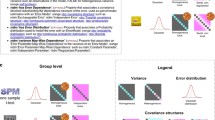Abstract
Current fMRI neuroimaging software programs offer the researcher a wealth of analysis methods and tools. However, the incompatibilities in user interface, data format, and computing environment in these tools make it difficult if not impossible for most researchers to take advantage of the full set of resources available for neuroimaging analyses. We describe a graphical computing environment, Functional Imaging Software Widgets (fiswidgets), which was developed to address these interoperability and usability problems. This environment provides a desktop style framework into which 100 subcomponents from a number of widely used fMRI analysis software packages (e.g., AFNI, AIR) are incorporated. It is an open-source, extensible environment available for reuse and modification by other software developers. A discussion of the design criteria (open architecture, modularity, wrapper technology, commercial utilities) that support such loosely integrative computing environments, and the problems entailed in maintaining them (development overhead, distribution logistics, format incompatibilities, graphics vs scripting tradeoffs, and appropriate acknowledgment of software developers) follows.
Similar content being viewed by others
References
Clapp, J., King, A., and Taub, A. (2001) COTS Commercial Off-the-Shelf Benefits and Burdens. The Edge Perspectives, MITRE Corporation newsletter vol. 3, number 1, Bedford, MA.
Cox, R. W. and Hyde, J. S. (1997) Software tools for analysis and visualization of FMRI Data. NMR Biomed 10: 171–178.
Flanagan, D. (1997) Java in a Nutshell, O’Reilly & Associates, Inc., Sebastopol, CA.
Frank, R.J., Damasio, H., and Grabowski, T.J. (1997) Brainvox: An interactive, multimodal visualization and analysis system for neuroanatomical imaging. NeuroImage 5(1): 13–30.
Fraser, T., Badger, L., and Feldman, M. (1999) Hardening COTS Software with Generic Software Wrappers. Proceedings of the 1999 IEEE Symposium on Security and Privacy, Oakland, CA, May 9–12.
Friston, K. J., Holmes, A. P., Worsley, K. J., Poline, J. P., Frith, C. D., and Frackowiak, R. S. J. (1995) Statistical Parametric Maps in Functional Imaging: A General Linear Approach. Human Brain Mapping 2: 189–210.
Goebel, R. (1997) BrainVoyager 2.0: From 2D to 3D fMRI analysis and visualization. NeuroImage 5,:S635.
Gold, S., Christian, B., Arndt, S., Zeien, G., Cizadlo, T., Johnson, D., Flaum, M., and Andreasen, N. (1998) Functional MRI Statistical Software Packages: A Comparative Analysis. Human Brain Mapping 6: 73–84.
Gosling, J., Joy, B., and Steele, G.L. (1996) The Java Language Specification (Java Series), Addison-Wesley.
Kimberg, D.Y. and Aguirre, G.K. (2001) VoxBo: a Flexible Architecture for Functional Neuroimaging, The Human Brain Project/NeuroInformatics Conference Abstract, Bethesda, MD.
Hoque, R. (2000) XML for Real Programmers, Morgan Kaufmann, San Diego, CA
Laird, C. and Soraiz, K. (1998) GUI toolkits: What are your options? SunWorld, March edition (www.sunworld.com).
Lewandowski, S.M. (1998) Frameworks for Component-Based Client/Server Computing. ACM Computing Surveys, vol. 30, no. 1, 3–27.
Orfali R. and Harkey D. (1997) Client/Server programming with Java and Corba, Wiley, New York.
Ousterhout, J.K. (1998) Scripting: Higher-Level Programming for the 21st Century. IEEE Computer, vol. 31, no. 3, 23–30.
Parker, S.G., Weinstein, D.M., and Johnson, C.R. (1997) The SCIRun computational steering software system, in: Modern Software Tools in Scientific Computing, (Arge, Bruaset and Langtangen, eds.) Birkhauser Press, Boston, MA. pp. 1–40.
Raymond, E. S. (1999) The Cathedral and the Bazaar: Musings on Linux and Open Source by an Accidental Revolutionary. O’Reilly and Associates, Sebastopol, CA.
Schach, S.R. (1999) Classical and object-oriented software engineering with UML and C++, 4th ed., WCB/McGraw-Hill, Boston, MA.
Smith, S., Bannister, P., Beckmann, C., Brady, M., Clare, S., Flitney, D., et al. (2001) FSL: New tools for functional and structural brain image analysis. Seventh Int. Conf. on Functional Mapping of the Human Brain.
Tracz, W. (1988) Software reuse myths. ACM SIGSOFT Software Engineering Notes, vol. 13, no. 1, 17–21.
Tracz, W. (1994) Software reuse myths revisited. Proceedings of the 16th international conference on Software engineering, May 16–21, Sorrento, Italy, pp. 271, 272.
Venema, W. (1992) TCP Wrapper: Network monitoring, access control and booby traps. Unix Security III Symposium, Sept. 14–17, pp. 85–92.
Woods, R. P., Grafton, S. T., Holmes, C. J., Cherry,
Author information
Authors and Affiliations
Corresponding author
Rights and permissions
About this article
Cite this article
Fissell, K., Tseytlin, E., Cunningha, D. et al. Fiswidgets. Neuroinform 1, 111–125 (2003). https://doi.org/10.1385/NI:1:1:111
Issue Date:
DOI: https://doi.org/10.1385/NI:1:1:111




